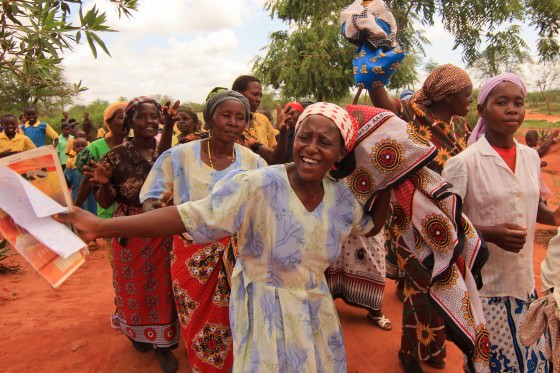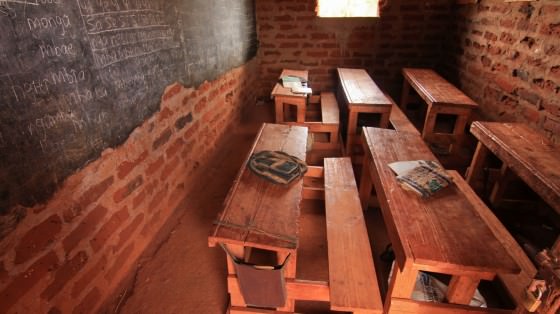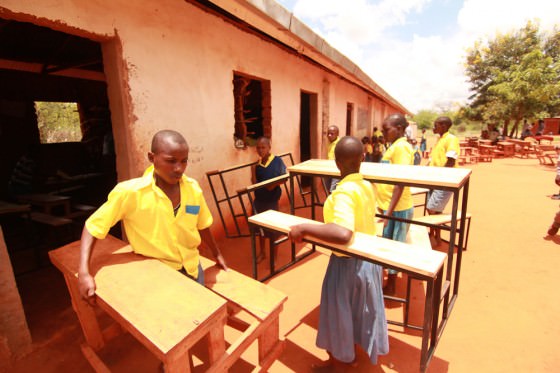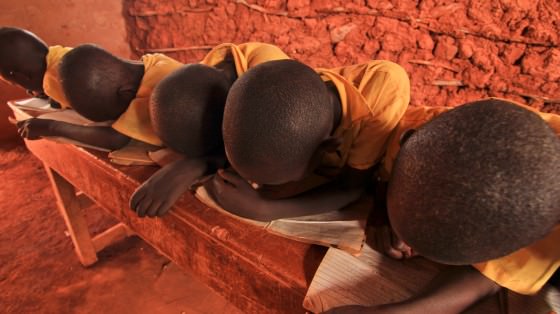As a long-time supporter of the David Sheldrick Wildlife Trust, I recently traveled to Kenya and was given the rare opportunity to accompany their community outreach officer on a very special trip.

We heard the joyous singing long before we could see the school. The voices were audible even over the loud rumble of the diesel engine. As we turned the final corner to the Misani Primary School, a magnificent scene awaited. Women wrapped in bright floral patterns, and men in their finest shirts, all dancing, clapping and singing in Swahili, their white teeth flashing in the late morning sun. We followed the dancing figures in the truck as they continued their procession towards the school. As we got closer, the students burst forth from their classrooms, a blur of smiling faces and bright blue and yellow uniforms. By the time we pulled up to the schoolyard, we were completely surrounded by people dancing, the cries of “jambo” and “karibu sana,” the only interruption to the happy singing all around.

There was cause for this great celebration. The back of the Sheldrick Trust’s largest transport lorry was filled to the brim with 30 desks to be donated to the school.
The Misani School, in the impoverished village of Kamunya is humble to say in the least. As student enrolment continues to grow, the already cramped classrooms had recently been subdivided even further to make 8 miniscule rooms partitioned by ¾ height mud walls. There are no doors and no electricity. Holes cut into the mud walls provide light and airflow in the stuffy classrooms. Before the arrival of the new desks, four to five students shared each table. So cramped was the writing space, that students were forced to sit diagonally on the benches and overlap their notebooks to allow their neighbor to write. The rough boards assembled to serve as desks looked like they were about to collapse. Despite being polished from years of use, most had clearly been constructed from the low quality wood of old shipping pallets. The benches creaked and were rife with splinters and rusty nails in need of hammering. Even if the students each had their own desk, the work surfaces were so cracked and riddled with knots that writing was nearly impossible.

The new desks, while simple in design offer a significant improvement. The welded steel frames and renewably sourced hardwood tops are handmade by local craftsmen and designed to last generations. The students will still have to share, but now they will have twice as much space on which to work.

Watching them proudly unload the lorry with the help of their parents and teachers, the excitement was contagious. In a matter of moments, all the desks had been carefully carried into the center of the schoolyard for the welcoming ceremony. Here, under the shade of young trees and the students sitting at their new desks for the first time, teachers and parents took turns to stand and sincerely thank the trust for all it had done in the community.

With the trust’s support and the help of many small hands, eighty native tree saplings were planted around the school. In just one year, those saplings had grown into the trees that provided the shade we were enjoying at the moment. Despite being a few kilometers away from the Tsavo National Parks, the vast majority of students had never seen a wild elephant, a hippo, or even a Zebra. Most families cannot afford the 250 Ksh (about $3 US dollars) park entry fee. Recognizing that giving these students the opportunity to interact with the wildlife that roams in their backyard could literally change their lives, the trust has arranged field trips into Tsavo East and West. Over the last two years, the trust’s dedicated 29-seat school bus has taken many of the students from the Misani School to Tsavo West, where they had the opportunity to visit Tsavo West Education Centre, Shetani Lava, Mzima Springs, Chaimu, Rhino Valley and Rhino Valley Game Lodge. Since their fieldtrips, many of the classes have formed wildlife clubs, in which they continue to learn about the animals they saw. For those that haven’t yet had the opportunity to go on a fieldtrip, the trust has brought in the mobile wildlife show to the school. For many, the wildlife film shown is the first movie the children have ever seen. Understandably, it makes a tremendous impact.
While the programs provided by the trust are a wonderful bolster to the community, the school still needs more support. The district head teacher stood before us and made a humble request for help building additional classrooms, office space for teachers, new textbooks, and even play toys for the children. Writing this, I am brought to tears. For most people in the modern world, classrooms, textbooks and balls to kick during recess are as much a part of school life as tests and homework – a certainty. Unfortunately, this is not so in much of Kenya. Many schools lack even the most basic supplies.

But for now, watching the students working at their new desks, I couldn’t help but smile. The simple gift of a desk had tremendously improved these students quality of life. Already, they were inspecting the welds in the steel and running their hands along the smooth writing surfaces. Hopefully, the new desks, in concert with the field trips, the wildlife clubs, the films, and the tree planting will help them learn about their priceless natural heritage. Today, it was easy to see that it was working.
To find out how you can help the Misani School and others like it, follow the link to the David Sheldrick Wildlife Trust Community Outreach programs.
